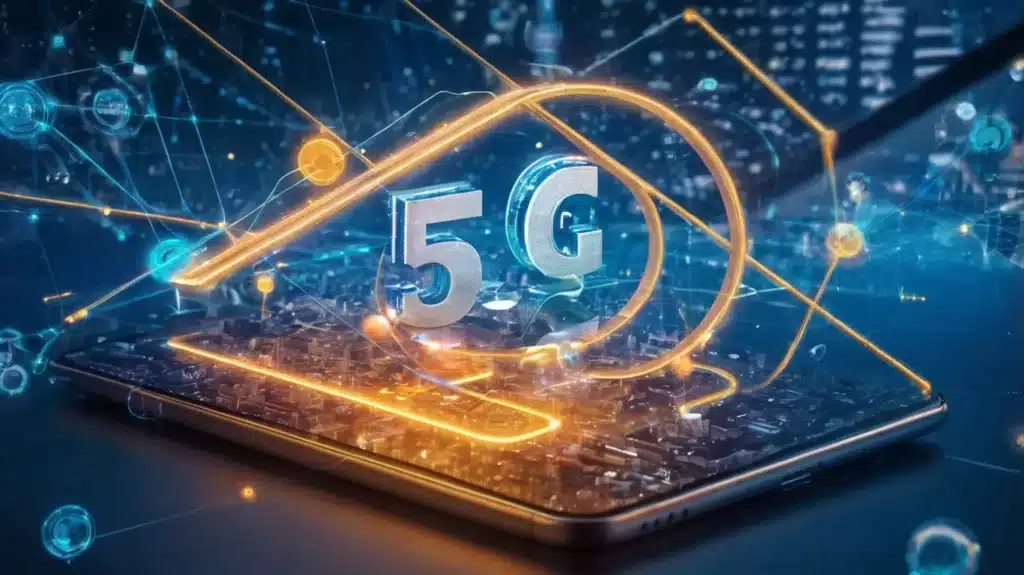Welcome to the era of 5G! As this advanced technology rolls out across the globe, it’s revolutionizing the digital landscape in ways we only imagined a decade ago. With its lightning-fast speeds and unprecedented connectivity, 5G is not just an upgrade to our current networks—it’s a transformative force reshaping how we interact with the digital world, from businesses to everyday activities. In this blog, we’ll delve into how 5G technology is altering digital marketing strategies and driving digital transformation with a significant focus on artificial intelligence (AI) integration. Get ready to uncover the profound impacts of 5G on our digital lives!
The Impact of 5G on Consumer Behavior

Faster Internet Speeds
The rollout of 5G technology has revolutionized consumer internet access by delivering dramatically faster speeds. This enhanced connectivity does not only mean quicker downloads and smoother streaming. It fundamentally alters how consumers interact with content online. With 5G, buffering becomes almost non-existent, and websites load in the blink of an eye. This shift leads to heightened expectations for instant access and can influence how consumers perceive brand efficiency and reliability. As consumers get accustomed to instant access, their patience for slower load times diminishes, pushing companies to optimize digital interactions to stay competitive.
Increased Demand for High-Quality Content
Alongside the need for speed, 5G also inflates consumer expectations for higher-quality content. With the ability to stream ultra-high-definition videos effortlessly, users are now gravitating towards more sophisticated, rich multimedia content. Marketers should note that it’s not just about resolution; immersive experiences such as 360 videos, augmented reality (AR), and virtual reality (VR) become increasingly commonplace. This trend compels content creators to elevate their offerings to capture and retain consumer interest. Websites, apps, and social media platforms need to adapt by incorporating these advanced forms of content, which are now more accessible thanks to 5G.
Evolution of Digital Marketing Strategies in the Era of 5G
Personalized Advertising with Enhanced Data Speeds
5G’s ultra-fast and reliable internet comes with a significant advantage for digital marketers: the ability to handle enormous volumes of data at unprecedented speeds. This capability allows for more sophisticated data analytics in real-time, giving marketers the power to tailor advertisements with incredible precision. Whether through location-based services, browsing history, or shopping patterns, brands can now deliver personalized ads that are exceptionally relevant to the individual consumer. This level of personal application aims to increase engagement and conversion rates, fostering a connection between the brand and the consumer that feels both spontaneous and attentively curated.
Utilizing Immersive Technologies for Enhanced Engagement
The introduction of 5G has opened new avenues for using immersive technologies in marketing. Augmented reality (AR) and virtual reality (VR) campaigns have become more feasible and effective with 5G’s low latency and high-speed capabilities. For example, furniture brands can use AR to let customers visualize how a piece of furniture would look in their home in real-time with stunning detail and accuracy. Similarly, virtual showrooms and interactive 3D product demonstrations engage customers in a way that was not possible before, creating memorable experiences that drive loyalty and sales. These technologies not only enrich the user experience but also give marketers creative tools to build deeper emotional connections with their audience.
Leveraging 5M for Real-Time Marketing Campaigns
5G significantly enhances marketers’ ability to implement and manage real-time marketing campaigns. With the increased speed and reduced latency, responses to real-world events can be instantaneous, enabling brands to engage with trends as they happen. For instance, during a sports event, brands could use real-time analytics to push relevant advertising content to fans, enhancing their experience and engagement during the game. This immediate interaction, powered by 5G, helps companies to stay relevant and appear more reactive and connected to current events in the eyes of the consumer. Such strategies, when executed effectively, can considerably boost brand visibility and audience engagement.
These transformative aspects show just how much 5G technology is setting the stage for the next big leap in digital consumer engagement and marketing strategies.
Reshaping the Online Landscape Through 5G Connectivity
5G technology is not just an upgrade from previous mobile networks—it is a major redefinition of how we interact with the digital world. This high-speed technology translates into virtually instantaneous connectivity that impacts everything from browsing social media to how businesses connect with consumers.
Improving User Experience with Lower Latency
One of the most notable improvements that 5G brings to the digital landscape is a significant reduction in latency. Latency, the delay before data begins to transfer following an instruction for its transfer, can be nearly ten times lower with 5G compared to its predecessor, 4G. This enhancement means that users can enjoy smoother streaming of high-definition video, more responsive gaming, and overall quicker uploads and downloads. For businesses, lower latency improves the efficacy of real-time applications, from live-streaming events to real-time customer service, ensuring that user experiences are seamless and more enjoyable.
Enhancing Mobile Marketing Capabilities
With 5G, marketers gain a powerhouse tool to engage users. Faster connectivity allows for higher quality content delivery, such as 4K videos and augmented reality experiences, directly on users’ mobile devices. Marketers can now create more engaging and interactive campaigns that were once only possible on high-end PCs or gaming consoles. Additionally, 5G opens up possibilities for real-time data analytics. Marketers can analyze how users interact with their content in real-time, allowing for immediate adjustments and optimization instead of relying on prolonged data collection and analysis.
New Opportunities for Location-Based Marketing
The precision of 5G significantly boosts the effectiveness of location-based marketing campaigns. With advanced geotargeting capabilities, businesses can tailor their marketing messages based on the specific location of a user within a much smaller radius. This means that promotions and ads can be made hyper-relevant and localized. For example, a restaurant can send special lunch offers to someone within a one-block radius during their lunch hour, thereby increasing the likelihood of attracting customers.
Case Studies: Successful Implementation of 5G in Marketing Strategies
As 5G technology continues to roll out, some companies are already ahead of the curve, integrating it into their marketing strategies with significant success.
Company A: Leveraging 5G for Enhanced Customer Engagement
Company A, a global leader in the retail sector, has utilized 5G to transform its customer engagement. They introduced an app that takes advantage of 5G’s low latency and high speed to provide an augmented-reality shopping experience. Customers can view how certain furniture pieces would look in their homes or how clothing items would fit on a personalized avatar. The app also uses AI to make recommendations based on user preferences and behaviors. Since the implementation of 5G, Company A has seen a 30% increase in app usage and a substantial uplift in customer satisfaction and sales.
Company B: Utilizing 5G for Targeted Location-Based Campaigns
Company B, a regional tourism board, adopted 5G to create highly personalized tourist experiences. By deploying 5G-powered kiosks and mobile apps, visitors can receive detailed information about nearby attractions, live events, and promotions based on their exact location. The initiative has enhanced tourist engagement, spreading visitors across more sites and helping alleviate congestion in overly popular areas. The accuracy and speed of content delivery have significantly improved visitor satisfaction and increased local business patronage.
In conclusion, 5G is ushering in a new era of digital connectivity and transforming the digital landscape. Its impact on marketing strategies is profound, offering businesses innovative tools to engage with their customers more effectively, pushing the boundaries of what’s possible in digital marketing.
Challenges and Future Trends in 5G-Powered Digital Marketing

Overcoming Privacy and Security Concerns
As businesses harness the power of 5G technology to boost their digital marketing efforts, new challenges emerge, particularly concerning privacy and security. The increased speed and connectivity that 5G offers also mean that consumer data can be collected and processed at unprecedented rates. This poses significant risks, such as potential data breaches and unauthorized surveillance. Companies must prioritize the implementation of robust security measures, including end-to-end encryption and regular audits. Establishing transparent data handling practices is equally crucial to maintain consumer trust and comply with stringent regulations like the GDPR.
The Rise of AI in Optimizing 5G Marketing Campaigns
Artificial Intelligence (AI) is playing an increasingly vital role in enhancing 5G marketing strategies. With 5G’s capabilities, AI can analyze large volumes of data in real-time, allowing marketers to tailor content more specifically to individual preferences and behaviors. This synergy leads to more effective and engaging marketing campaigns that reach the right audience at the optimum time. For example, AI-driven algorithms can predict customer trends and automate personalized advertising content instantly across multiple platforms. This not only increases the efficiency but also the relevancy of digital advertising efforts.
Predictions for the Future of 5G in Digital Marketing
Looking forward, the integration of 5G in digital marketing is set to revolutionize how brands interact with their audiences. Here are a few predictions:
– Increased use of Augmented Reality (AR) and Virtual Reality (VR): These technologies will become more prevalent in marketing campaigns as 5G reduces latency issues, providing seamless and immersive user experiences.
– Real-time data-driven marketing: Marketers will be able to leverage real-time data to make immediate adjustments to campaigns, enhancing responsiveness and effectiveness.
– Growth in mobile commerce: Faster connectivity will boost mobile commerce, as transactions can be made more quickly and smoothly than ever before.
In conclusion, while 5G presents new challenges, particularly in privacy and security, its potential to enhance digital marketing through AI and other technologies is profound. Embracing these changes will be key for marketers aiming to succeed in the rapidly evolving digital landscape.
Conclusion: Embracing the 5G Revolution in Digital Marketing
The era of 5G is not just coming; it’s here, bringing transformative possibilities to the digital landscape. As marketers, embracing this technology is indispensable. The capabilities of 5G to enhance speed, improve connectivity, and support advanced technologies like AI, redefine how we connect with consumers, making personalized and real-time marketing not just possible but more proficient.
– Speed: With unprecedented download and upload speeds, campaigns can be more dynamic and media-rich.
– Connectivity: Improved connectivity means reaching consumers in previously inaccessible areas, broadening market reach.
– AI Integration: Faster data processing enhances AI-driven analytics, improving campaign effectiveness.
In light of these advancements, digital marketing professionals need to stay ahead by continuously adapting their strategies and embracing innovative tools. The digital ecosystem is rapidly evolving with 5G, and those who are prepared to leverage its benefits will find themselves at the forefront of this new era. Embrace this change, explore the possibilities, and transform challenges into opportunities to thrive in the future digital marketplace.
For More latest tech news, follow Gadgetsfocus on Facebook, and TikTok. Also, subscribe to our YouTube channel.

